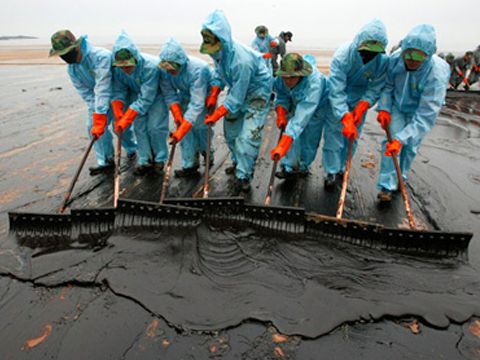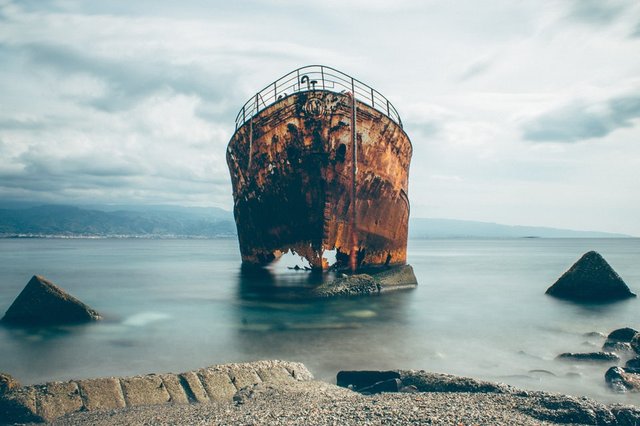Bioremediation: Living Cleaners
There is a large variety of micro-organisms and some of them like to eat what we consider contaminants. Common contaminants are oil and petroleum-based products, solvents, and pesticides. The micro-organisms have the ability to transform these contaminants into harmless gases and water. This process of cleaning an area of contaminants using micro-organisms is called bioremediation.

Bioremediation of oil spills - BioNanoSol
Introduction to Bioremediation
If an area contains contaminated groundwater how can we clean it using micro-organisms? First, we must gain access to the water, which means either pumping the contaminated water to the surface for treatment in a bioreactor or injecting things into the ground itself. The downside of bringing it to the surface is that always some contamination remains and, secondly, in the controlled reactor waste and sludge are harder to remove.
Preferably, we go to the contamination, which is aptly called in situ bioremediation. The benefit of being in situ is that the native micro-organisms often have started the process of bioremediation themselves, it just goes quite slowly. The trick is to speed up the existing biochemical reactions so that the contaminant is rapidly broken down. This can be done by injecting into the ground more of the native micro-organisms performing the reaction, adding nutrients for the native bacteria, and adding electron acceptors.
For those of you who are unfamiliar with the term electron acceptor, I include a bit of the chemical reactions that are characteristic in bioremediation. The degradation by micro-organisms happens through reduction and oxidation (redox) reactions. These reactions are between electron donors (the oxidized compound) and electron acceptors (the reduced compound). The formation of rust, which is oxygen (O2) reacting with iron (Fe) is also a redox reaction:

- Oxidation of iron: Fe(s) -> Fe2+(aq) + 2e-
- Reduction of oxygen: O2(g) + 2H2O(l) + 4e- > 4OH-(aq)
- Redox reaction: 2Fe(s) + O2(g) + 2H2O(l) -> Fe2+(aq) + 4OH-(aq) -> Fe(OH)2(s)
The redox reaction of rust (Fe(OH)2) – Notation between brackets: s for solid, l for liquid, aq for ionized in water, and g for gas. The notation e- resembles a free electron.
Two different types of degradation are possible: aerobic and anaerobic. Aerobic degradation is where micro-organisms use oxygen as electron acceptor. Anaerobic degradation occurs when there is no access to oxygen, which happens quite often due to the limited solubility of oxygen in water. Electron acceptors such as nitrate, sulfate, and manganese are used (Figure 1). Aerobic degradation tends to be much faster than the anaerobic version.
Figure 1: The electron acceptors used by anaerobic microbes. In preferential order: nitrate, manganese, ferric iron oxyhydroxides, sulfate, and carbon dioxide.
The trouble-causers
There are three types of compounds that are often in need of remediation. These are the hydrocarbons, chlorinated compounds, and nitroaromatic compounds.
Primary examples of hydrocarbons are benzene, toluene, ethylbenzene, xylene and polycyclic hydrocarbons. These hydrocarbons are often well treatable using aerobic bacteria that break the aromatic carbon ring. However, the process suffers when oxygen is not available in sufficient amounts, which again is due to low solubility. Therefore anaerobic bacteria have to be used to get the job done. An example is the cleaning of a site contaminated with diesel. Nitrate and phosphate were added as nutrients and the hydrocarbons in the oil were degraded.
Chlorinated compounds are usually chlorinated ethenes. An ethene is two carbon atoms with a double bond (C=C). The side groups of both C’s can be filled with chlorine atoms (Cl) instead of hydrogen atoms (H). Perchloroethylene (PCE) has all four available places on the carbon atoms filled with Cl, and it is resistant to aerobic degradation. Luckily there are sufficient micro-organisms available to deal with these chlorine compounds (Figure 2). The PCE is converted into the safe ethene.
Figure 2: Dechlorination of PCE to ethene.
The third group, nitroaromatic compounds, is mostly due to our military activities. The primary contaminant here is 2,4,6-trinitrotoluene, which chemists will recognize as TNT. The nitroaromatic part of TNT can be broken down to nitrite or fully reduced to the lovely smelling ammonia.
There is dry cleaning solvent in the groundwater! - New Jersey
An example of the application of bioremediation is in the cleaning of groundwater near New Jersey that was contaminated with the dry cleaning solvent perchloroethylene (PCE). PCE is an expected carcinogen but evidence is limited. It is also lethal at high dosage due to it affecting the central nervous system.
The contaminated area was quite large, as it was 1800 feet long, 500 feet wide, and up to 40 feet underground. To remediate the contaminated ground the micro-organisms that are native to local area were used. The problem is that they couldn’t grow to sufficient numbers due to a lack of required resources. Therefore vegetable oil and baking soda were injected and combined with the addition of more micro-organisms. Testing has shown a decrease of the PCE concentrations in the ground, although it could take a while before it is cleaned fully. Microbes aren’t always the fastest, and it can take months or up to several years.
References:
Contaminated environments in the subsurface and bioremediation: organic contaminants
A Citizen’s Guide to Bioremediation
State Funded Dry Cleaner Remediation Program
Perchloroethylene
Bioremediation
Corrosion of Iron
Images:
Unsplash
Recently from @Altherion
A Case for the Moon Base
Legumes: A comprehensive processing overview
The Nano World – Atomic Layer Deposition
Survival of the Fattest
by FoodLabScience
Twitter

A scientist’s food for thought!
Hi. Excellente post. I teaching environmental microbiology and I know a little about biorremediation. I'm interested in role of microorganism to remediate the environment. The past year, with an student, I developed a study about bacteria whit potential to degradation of polyethilene terephtalate. Congratulation by your post.
Thank you @lepapillonvzla, that sounds very interesting! Were you able to have some success with the PET degrading bacteria? I found some articles that mention a couple strains that produce the necessary enzymes for PET breakdown, such as Ideonella sakaiensis, and cutinase from Fusarium oxysporum that was built into E. Coli.
good science @altherion..
nice post, I hope you write again about something that inspires like this ...
Best Regards @fikrihaikal
Thank you @fikrihaikal, maybe you would like this related post on wastewater treatment.